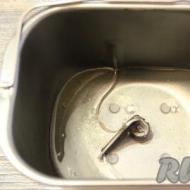
Proper topping up and changing car oil. Adding oil to the engine: when it is needed and how it is done correctly How to add coolant to the car correctly
Change frequency engine oil determined by the maintenance schedule. However, any engine internal combustion consumes lubricants during operation. In some vehicles, this is provided by the manufacturer.
Filling oil in a Hyundai engine
Engines with mileage or with malfunctions consume engine lubricant in excess of the norm. In any case, car owners are faced with the need to compensate for the consumption of lubricant "for waste".
How to add oil to the engine without damaging it? It would seem that everything is simple: you must initially purchase consumables with a margin, and add lubricant in the process of consumption (planned or not).
However, packaging is not always rational in terms of volume, and the car owner has to overpay for extra liters, which are not always in demand.
How much oil to add to the engine?
To control the level, an oil dipstick is provided in any internal combustion engine. It is necessary to make it a rule to check the volumes of technical fluids at least once a week.
The easiest way is to do this before you start moving. If your car is in a garage or in a parking lot: before starting the engine, open the hood, remove the dipstick, wipe it dry. Then put it back in and take it out again.

Engine oil level on dipstick
The main condition is a flat horizontal surface: if you park on a curb, the readings will be incorrect. The oil mark should be between the "MIN" and "MAX" marks.
As a rule, the difference between these marks is 1 liter. It is not necessary to strictly maintain the middle, an oil trail anywhere between the risks means a normal level.
Important! Too much oil is no less harmful than too little oil. "Extra" lubricant gets on piston group, under the influence of temperature, it is stratified into components, and precipitates in the form of slags. Deposits clog oil channels, disrupting circulation.
In addition, excess lubrication leads to an increase in pressure in the crankcase, as a result of which oil seals or gaskets may depressurize: they are simply squeezed out of seats. Excess fluid loads oil pump, which leads to accelerated wear.
Accordingly, a low level leads to oil starvation (the consequences can lead to an unplanned overhaul).
How to add oil to the engine?
- it is necessary to approximately determine the missing volume (if the mark is at the “MIN” risk level, it will be 0.5 l), and add fresh grease;
- after which you need to start the engine, let it run for 5-10 minutes, turn it off, and wait 10 minutes until the grease drains to the bottom of the crankcase;
- re-measure the level (remove the dipstick, wipe it, put it in and take it out again).
It is enough to carry out this procedure 1 time, and you will know exactly how much liquid is between the two risks on the dipstick.
Is it possible to add oil from another manufacturer to the engine?
Basically, trademark does not define characteristics lubricants. If the SAE viscosity specifications and API tolerances are correct, big problem when mixed will not. 
Of course, the ideal option is to have a supply of oil that you filled in at the next maintenance. But in practice this is not always possible.
The fundamental question is the conformity of the basis. Mineral oil should not be added to synthetic, and is not recommended to be mixed with semi-synthetics. In a critical situation, if the level drops on the road, and you don’t have a supply of the “correct” oil with you, you can add synthetics to semi-synthetics.
Emergency: the lubrication level is critically low, it is impossible to select the correct consumable.
In this case, fill in any oil that is as close as possible in terms of characteristics. Here we choose the “best of two evils”: without oil, the engine will definitely fail, and with the “wrong” lubrication, you can reach the service station.
The main thing is to drive at low speeds, without overloading power plant. When you get to a place where you can service the car, change the oil immediately, if possible with washing the engine.
When to add oil to the engine?
The question is rather rhetorical. Of course, immediately after detecting a low level. As a rule, the owner of the car knows what kind of lubricant consumption “for waste” the car has. Regularly looking at the odometer, you can accurately determine the need to replenish the volume. At the same time, no one canceled regular monitoring.
If 1000-1500 km are left before the next scheduled maintenance, it makes no sense to spend fresh engine oil on topping up. Perform maintenance ahead of time. At the same time, you should purchase new oil with a margin, since you know exactly how much fluid will have to be added during the interservice period.
Is it possible to fill in engine oil "with a margin"?
No, you can't do that. If you know for sure that the engine “eats” oil, and there is a danger of being in the middle of the track with a critically low level, fill in the liquid to the “MAX” mark (not higher!), And control the level as often as possible. Always keep a liter canister with a reserve in the trunk.
How to add oil to the engine - video
In any case, with a critically high consumption of engine oil, it is necessary to identify the cause and put the engine in order.
Dear friends, today we would like to highlight the topic of automotive antifreeze. Without this tool, the car simply will not be able to function correctly. Antifreeze appeared to the automotive world as a worthy replacement, which was discontinued on production cars years ago. Technical progress moves forward with large and confident steps. To date, for each car model, a certain type of this consumable.
In this article, we will tell you how to properly replace antifreeze in your car. This article is a clear step-by-step guide for beginner motorists. Why for beginners? Because such a process as replacing antifreeze is quite simple, and experienced car owners most likely will not experience any difficulties when performing this procedure.
What is antifreeze, and what is its composition?
is an antifreeze liquid with toxic properties, based on ethylene glycol (non-toxic, but more expensive propylene glycol is less often used) with the addition of water and various additives that provide it with special properties. The additive package may include corrosion inhibitors, compounds that prevent foaming and cavitation, and fluorescent dyes.
The physical characteristics of ethylene glycol come in handy for using it as a base for antifreeze. In addition to lowering the freezing point, it also raises the boiling point, and this allows you to charge the system, significantly expanding the temperature range of its application.

As stated above, dyes are added to the non-freezing liquid, signaling the main properties of the liquid. They also play the role of a “litmus test” and, during the development of additives, lose their color intensity, further reporting that the liquid is no longer suitable and needs to be replaced. Due to the cooling properties of antifreeze, you will need some knowledge on how to properly fill it. It is necessary to avoid all sorts of mistakes that can be made in car care.
To find out how much antifreeze to fill in, you should refer to the car manual. The best option, of course, there will be an appeal to a car service. There, they will conduct a qualitative inspection of the car’s cooling system, as well as the correct replacement of antifreeze, followed by appropriate recommendations.
Preparation of antifreeze for the bay
Firstly, antifreeze should be changed on average every 75,000 kilometers. If you do not make such distances, then you should complete replacement coolant every two years. There are some criteria that contribute to the premature replacement of antifreeze. They may depend on the operational period and technical condition. vehicle. An unscheduled replacement of antifreeze is carried out if:
- antifreeze has darkened or clouded;
Your vehicle's engine has been overhauled and the coolant has been drained;
Cooling system components damaged due to antifreeze leak.
 Before proceeding with the replacement of antifreeze, decide on its type and type that is suitable for your car model. We advise you not to reinvent things that have already been invented before you, and therefore refer to the manual of your vehicle, in which everything is clearly described. If the store shelves do not have the antifreeze model you need, consult a specialist who will select a coolant with similar properties that will ideally suit your car.
Before proceeding with the replacement of antifreeze, decide on its type and type that is suitable for your car model. We advise you not to reinvent things that have already been invented before you, and therefore refer to the manual of your vehicle, in which everything is clearly described. If the store shelves do not have the antifreeze model you need, consult a specialist who will select a coolant with similar properties that will ideally suit your car.
Drain antifreeze
So, the necessary model of antifreeze has already been acquired, which means that you should proceed to its direct replacement. Of course, you can entrust the replacement of the coolant to qualified specialists by driving the car to a car service, but you can do it yourself, saving money. As we mentioned earlier, this is not at all difficult. We will immediately make a reservation that initially it is necessary to completely drain the antifreeze from the machine system, and then fill it with new consumables.
To get started, be sure to park your car on a level surface. This is necessary in order to clearly see the level of antifreeze in the cooling system. After that, drain the coolant, clearly guided by a certain algorithm of actions:
1. Prepare and place a container under the antifreeze drain;
2. Unscrew the antifreeze drain valves from the system. Open them carefully to prevent spillage of antifreeze. Drain gradually;
3. After draining the main part of the coolant, unscrew the expansion tank cap.
Please note that the taps and pipes may be located in different places, depending on design features your car.
How to fill in antifreeze?
 After the process of draining the coolant is completed successfully, seal the cooling system by closing all pipes and taps. After that, you can finally proceed to the bay of new antifreeze. This is also done according to a certain algorithm:
After the process of draining the coolant is completed successfully, seal the cooling system by closing all pipes and taps. After that, you can finally proceed to the bay of new antifreeze. This is also done according to a certain algorithm:
1. To prevent antifreeze from spilling, it is necessary to install a watering can in expansion tank or radiator;
2. After that, fill in antifreeze. This should be done gradually, without pouring out all the antifreeze at once. If the pressure is too high, an air lock may form, which will prevent the car's cooling system from working correctly in the future;
3. Note that the expansion tank has "minimum" and "maximum" marks. It is recommended to fill in liquid no higher than the minimum mark;
4. Tighten the cap of the expansion tank tightly;
5. Start the engine and let the car stand for about 10 minutes, observing the condition of the coolant;
6. Add antifreeze to the minimum mark in the expansion tank.
 That's all the action. Now you know how to fill in antifreeze correctly. After all the above procedures, start the car and let it reach the desired temperature power unit. Check the condition of the cooling system and the level of antifreeze. In no case should the liquid drop below the minimum mark. Everything is fine? Sit quietly behind the wheel. It's important to know! We want to warn you finally about the mistake that many beginners make: in no case do not open the cap of the expansion tank while the engine is running, because this threatens to splash antifreeze, which can lead to burns on exposed skin.
That's all the action. Now you know how to fill in antifreeze correctly. After all the above procedures, start the car and let it reach the desired temperature power unit. Check the condition of the cooling system and the level of antifreeze. In no case should the liquid drop below the minimum mark. Everything is fine? Sit quietly behind the wheel. It's important to know! We want to warn you finally about the mistake that many beginners make: in no case do not open the cap of the expansion tank while the engine is running, because this threatens to splash antifreeze, which can lead to burns on exposed skin.
Many novice drivers are concerned about the question of how to pour oil into a car engine. This seemingly simple event has many pitfalls and it is not as easy to deal with it as it seems. Each engine has its own characteristics, and therefore there are a huge number of nuances that must be considered before filling in the lubricant.
Why add oil
High-quality operation of the engine is impossible without engine oil. This viscous substance performs several main functions, providing:
- cleanliness of engine parts;
- ease of cold start of the engine;
- reliability of operation at the highest possible temperature of the parts of the cylinder-piston group;
- heat removal from heated parts;
- lubrication of moving parts;
- neutralization of aggressive and corrosive compounds accumulating in the power unit.
Each of the points is handled by certain additives added to oils to enhance them. performance characteristics. Before pouring oil into the engine, it is necessary to determine what type of fluid is suitable for it. Today there are a large number of motor lubricants, and within even one line you can find products with different parameters. So, mineral, synthetic and semi-synthetic oils are produced. Each of them can be winter, summer or all-season. In addition, car manufacturers may recommend the use of a particular oil. Because different kinds oils cannot be mixed, first of all you need to find out what brand of lubricant is poured into the engine. This question should be answered by the employees of the car dealership where the car was purchased, or by its previous owner. If the truth is unknown, you will have to completely change the oil. This procedure can be performed independently or contact the service station.

- for a new engine - synthetic oils of class SAE 5W30 or 10W30 (at any time of the year);
- for a used engine, but technically sound - SAE 10W40 in the warm season, 15W40 in winter and 5W40 all season;
- for an old model with a used engine - SAE 15W40 in summer, 5W40 or 10W40 in the cold season, 5W40 regardless of the season.
At the same time, it must be remembered that the maintenance of engines of obsolete designs does not involve the use of modern synthetic oils, which is largely due to their increased penetration rate, as a result of which the rate of oil leakage through ill-fitting parts of the motor increases. Some inexperienced drivers wonder why they often have to add oil to the engine, while professionals approach this issue very responsibly. In some cars, the lubricant burns out very quickly, but increased oil consumption does not always indicate a malfunction of the power unit, just as long-term use of the fluid does not indicate the absence of problems in the engine. In many cases, fuel consumption depends on the type of engine and its volume. So, for small cars, a consumption of 1 liter per 1000 km is considered large, and for cars with a V6 or V8 power unit, it is the norm.
Back to index
How is the amount of lubricant in the motor determined?
Each owner of the "iron horse" can independently determine how much lubrication is in the engine and whether oil needs to be filled. As a rule, the required amount of oil in the power unit is indicated in the technical documentation for the car. The fluid level is determined with the motor turned off or 10 minutes after it has completely stopped, or before starting. For the measurements to be correct, the vehicle must be on a horizontally level surface.

Oil selection according to characteristics
Each car comes with a special dipstick for measuring oil. As a rule, it is located in front of the engine and is a thin metal bar with applied divisions. To pull out the probe, you need to grab the ring handle and pull it towards you. Then you should wipe the dipstick from the oil, lower it into the engine until it stops and pull it out again. The amount of lubricant in the motor is determined by the marks. If the oil reaches the top mark, no fluid needs to be added. If it approaches the bottom, the engine needs lubrication. Experienced experts recommend checking the oil level at least once every 7 days. Each car model requires a certain amount of engine lubricant. So, when preparing oil for filling, it should be taken into account that domestic-made cars need a liquid volume of about 4 liters, foreign cars with an engine capacity of up to 2.4 liters - up to 4 liters, and cars with larger engines - over 4 liters. So, the oil level is checked and you can start adding lubricant to the engine.
Back to index
Algorithm for filling oil in the engine
Where to pour oil? For this, there is a special oil filler neck located above the engine block. It can be distinguished by the Oil Fill mark or by the type of oil recommended by the manufacturer (for example, 5W40). Remove the cap from the neck, wipe with a rag and set aside.
Then, insert a crow into the resulting hole and carefully pour no more than 1 cup of oil. When the liquid sinks into the sump (this will happen after 15-20 minutes), you need to check the oil level with a dipstick. If it is not high enough, the procedure should be repeated. The probe must be wiped with a cloth each time you take a measurement. A sufficient amount of lubricant in the motor will be signaled by a level approaching the maximum mark. After that, remove the funnel from the hole, close the neck with a lid and install the probe in its place.
Back to index
Complete engine oil change
In the event that the type of oil filled into the engine is unknown, a complete fluid change should be made. The main thing here is to do it right. Before filling in new grease, you must drain the old one.
First of all, you should choose a place for the procedure. A special pit in the garage looks like an ideal option, but if there is none, a replacement can be made in a field or in a summer cottage. It is not recommended to change the oil with a cold engine - such a substance is too viscous and cannot be completely drained. To completely free the engine from old grease, warm up the engine and carry out the procedure 10 minutes after turning it off. In order to drain the oil, you will need to put the car on hand brake and lift it up with a jack. In no case should the car roll when there is a person under it, so you can secure the hand brake with heavy bars or cinder blocks, supporting the wheels with them. In addition, you will need to prepare:
- an old bowl or basin;
- a bottle of 3 or 5 liters;
- wrench;
- oil filter.
The process of draining old oil is quite simple: you need to find the engine drain hole on the bottom, place a basin under it and unscrew the plug. To prevent hot oil from burning your hands, it is advisable to wear gloves. It will take about 30 minutes for the liquid to completely glass into the bowl. This time can be taken by replacing oil filter. After a while, it is necessary to tighten the drain plug (this should be done very carefully so that the thread does not curl under force), lower the jack and return the car to a horizontal position. Now you can fill in the oil. The procedure is carried out in the same way as described above.
After that, you need to check how the engine works. To do this, you need to start the car and look at the sensor on the instrument panel. If the sensor lights up, but goes out after 5-10 seconds, the oil has got to the right place and is ready to go. Experienced drivers recommend driving a car for several kilometers and rechecking the lubrication level (10-15 minutes after the engine stops). If the readings have not changed, everything is in order. If the volume of oil has decreased, there is a leak somewhere: perhaps the drain cover is not tightly closed or the pipes are leaking. It is necessary to leave the car for the night, and in the morning look under the bottom. An oil puddle will signal a leak. Timely topping up and replacing engine oil will guarantee trouble-free operation of the engine of both a new and a used car.
Antifreeze is a special liquid designed for the car's cooling system. The peculiarity of this substance is that it does not freeze even when low temperatures. And this effect is possible due to the special composition of the liquid - ethylene glycol and water, which together form a dihydric alcohol. Antifreeze also contains so-called inhibitors - substances that slow down the corrosion process.
For the smooth operation of the car, it is extremely important to replace the antifreeze in a timely manner. we have already told you from the car, but we will describe in detail how to fill the cooling system with new antifreeze in this article.
| The content of the article: |
Terms for replacing antifreeze
The exact service life of the consumable cannot be called just like that - it all depends on the manufacturer of the refrigerant, the composition of the coolant and the additives added to it. Today, in the domestic market, you can find coolants made on the basis of silicate or carboxylate.
For example, foreign-made coolants that contain silicate must be replaced at least every 3 years, or once every 100-150 thousand km. run. Carboxylate-based antifreezes, under ideal conditions for the operation of the engine and cooling system, can work for at least five years or 250 thousand kilometers.
How to pour antifreeze into the cooling system?
New antifreeze is recommended to be poured only into a clean cooling system. However, before that, it is important to understand what exactly you are going to fill in. After all, there is no such confusing classification as that of coolants anywhere else.
To avoid education air locks in the system, put the car in a strictly horizontal position.
1) . We disconnect the uppermost pipe that supplies antifreeze to the engine (as a rule, it is located in the intake manifold area).
2) . Pour new antifreeze through the neck of the expansion tank, which is most conveniently done using a funnel.
3) . We fill it until it starts to flow out of the disconnected pipe, after which we put the pipe in place and clamp it at the junction with a clamp.
4) . The optimal level to fill is between the "MIN" and "MAX" marks.
5) . After pouring, close the tank cap tightly, start the car and warm it up until the fan turns on.
7) . Top up if necessary. Once again I want to note that the last point is performed only with a cold engine.
How to pour antifreeze into the cooling system (Video)
Video #1
Video #2
How much antifreeze should be added?
The amount of antifreeze that needs to be poured into the car's cooling system is usually indicated in the instruction manual for a particular model. But on average, this figure is 6-8 liters.

You can navigate using the "MIN" and "MAX" marks on the expansion tank. That is, as noted above, the liquid level in the tank must be between these marks.
How to add antifreeze to the cooling system?
You should find out the brand, type of liquid and supplement the contents to the required level with an identical composition. Work should only be carried out with a cold engine.
We first slightly open the cap of the expansion tank, which will eliminate excess pressure, after which we completely unscrew the cap and add antifreeze (we focus on the “MIN” and “MAX” marks).
It is not necessary to add antifreeze to the eyeballs, which is fraught with splashing out excess and getting them on the working parts of the power unit in a warm state.
What kind of antifreeze can be filled in?
What are they like? According to their composition, they are divided into:
- silicate;
- Carboxylate;
- Hybrid.

Each type has its own characteristics and characteristics.
silicate. They contain salts of inorganic acids - the main additives of this type of coolant. A negative characteristic of such a liquid is the formation of plaque. Salts form a thin film of plaque over time. It settles and does not allow the system to fully work, which can lead to heating of the car engine. Consequently, and to a greater consumption of oil and fuel.
Carboxylate. Contains organic acids. This type of antifreeze has the following designations: G12 or G12 +. Organic acids, unlike inorganic acids, do not form scale and plaque. They differ in anti-corrosion and anti-cavitation properties.
hybrid. Contains both organic and inorganic acids. This type has the following designation: G11. Combines the positive and negative properties of the two previous types.
A novelty among coolants is lobrid antifreeze - G12 ++ and G13 containing organic bases and mineral additives. Due to the unique composition, this substance can last up to 100,000 km.
The most common and popular option, although not of very high quality, is “Traditional Antifreeze”. Its service life is not more than 2 years. This type cannot withstand high temperatures. It starts to boil at 105 degrees Celsius. Of the "Traditional Antifreezes" antifreeze is the most famous.
Selection rules . When choosing a coolant, one should be guided by the qualitative features of each type. The presence of various additives significantly affects the quality and service life of the fluid. The quality and service life are also affected by the presence of various additives.
The lowest percentage of additives in G11 coolants, which affects product quality. It is not able to protect against scale and corrosion. The service life of this type of substance is not more than 2 years. In the case of large runs, it can be reduced to 6 months.
Antifreeze coolants such as G12 have a longer service life. As a rule, they have it from 4 to 5 years.
Carbon coolants without replacement can last at least 5 years.
Features and Warnings . Sometimes it becomes necessary to top up the coolant. To do this, you should purchase a new antifreeze of exactly the same type that is already poured into the car. Avoid mixing different types of liquids, even if they are the same color. It is highly forbidden to mix G12 and G11 antifreezes. They are incompatible.
G12+ fluids are miscible with two other types.
Is it possible to pour water into antifreeze?
If you convey the essence of the manufacturer's recommendations, then it is strictly forbidden to add water to antifreeze. This ban is justified by the fact that the coolant is enriched with appropriate additives that have a beneficial effect on the cooling system. They contribute to excellent lubrication and accelerated cooling of the engine.
How to find out what is flooded, antifreeze or antifreeze?
As a rule, motorists know what is poured into their cooling systems. But this is the case if we are talking about a permanent owner of a car. In fact, there can be a lot of reasons why a motorist wants to know what exactly is poured into the expansion tank of his car.
How to determine what is filled? There is a myth that antifreeze tastes sweet, but this is nothing more than just a myth. Yes, and you need to be careful when "tasting" - the chemicals that make up the coolant are extremely toxic.
What should a motorist do if he wants to know what kind of refrigerant is poured into the cooling system of his car?
- Feel and smell. Traditional antifreeze is odorless and feels oily to the touch. Russian "Tosol" to the touch will not be as oily.
- For resistance to frost. If you pour a small amount of coolant into a bottle and place it in the freezer, then it should not freeze. If it is frozen, then most likely it is "Tosol" of poor quality production, if not, then this, in all likelihood, is high quality antifreeze.
- Consumable compatibility with tap water. Take some coolant from your car's system and pour it into a bottle. In a one-to-one ratio, pour ordinary tap water into this bottle, wait about an hour. If you see a bundle of substances, the mixture is cloudy or there is a precipitate, then this is "Tosol" Russian production. When using high-quality foreign antifreeze, this should not occur.
- You can find out which refrigerant is filled in by density. But for this you will need a hydrometer - a special device for checking the density of the coolant. The test of the substance is carried out at an ambient or room temperature of more than 20 degrees Celsius. If the density of a substance is from 1.073 to 1.079 g / cm3, then you most likely have a good antifreeze.
Any internal combustion engine generates a lot of heat during operation. So that it does not boil, there is a cooling system. The antifreeze that it contains is needed to cool the block and engine head. In addition, in winter, the heat removed from the coolant is sent to the stove radiator - it becomes warm in the cabin. But let's imagine the situation: one morning you decided to check the coolant level in and saw that it was at a minimum. Can I add water to antifreeze? Let's answer this question.
The structure of antifreeze
This one has two main components. These are ethylene glycol (63 percent) and water (35 percent). The rest is various additives - corrosion inhibitors. Thanks to this composition, antifreeze does not boil at a temperature of 100 degrees or more, and also does not freeze at zero.
Ethylene glycol is based on a glycol-water mixture. The ability of a liquid not to freeze at a negative temperature depends on its quality. Also, the glycol-water mixture affects the viscosity of the antifreeze and its specific heat capacity. However, its aqueous solution has an aggressive effect on the metal elements of the cooling system. Therefore, the composition necessarily includes additives that prevent their corrosion.
When can antifreeze be mixed?
The cooling system must operate at normal coolant volume. Its deficiency can lead to overheating of the motor. But is it possible to add water to antifreeze? The liquid itself is already a concentrate of ethylene glycol and water. But not simple "from the tap", but distilled. These are two different things. By the way, foreign manufacturers make pure ethylene glycol, in which the percentage of impurities (water and additives) does not exceed 5 percent. The proportion of mixing of these components depends on the conditions in which the vehicle is operated. For example, for mid-latitudes, this ratio is 1 to 1. If a concentrate was previously poured into the system, it can be diluted with 200 ml of distilled water if the level is insufficient. With this ratio, the properties of antifreeze and its freezing point are not violated.
Why only distilled?
Please note that tap water is absolutely not suitable for diluting the coolant. It contains a large percentage of impurities, which not only worsen the properties of antifreeze to remove heat. The wear of pipes also increases, corrosion of metal elements occurs, salts clog in the radiator. Over time, it will simply clog in one of the channels and cause the motor to overheat.

To avoid engine problems, don't skimp on distilled water. But if you urgently need to go, but you don’t have either one or the other at hand, you can add water, but only boiled water. And after such mixing, the antifreeze is completely drained and a new one is poured. You can't ride on the water for a long time. You can use it as a new liquid. Its price is about 300 rubles for a five-liter canister. For passenger car she's enough. But for minibuses and trucks of the GAZelle type, 10 liters are needed. But still, this price is not comparable to the repair of the motor, which you will need in case of overheating.
Is it possible to add water to antifreeze in summer?
If you have not diluted the concentrate before, then it is quite safe. Some motorists use it as their main coolant. But this is only until the first frost. Before the onset of cold weather, preventive maintenance of this system should be carried out. If it was topped up (or it was used as the main one, it doesn’t matter), we drain it and fill in a new, full-fledged red antifreeze. The price of a mistake and laziness is a frozen tank and the replacement of all pipes.
Winter time
During this period, it is strictly forbidden to add water, even in small quantities. As a result, starting the engine at -5 or more degrees will be difficult. Frozen water due to expansion can break the radiator, pipes and tank. According to the requirements, the freezing point of antifreeze must be at least -25 degrees. With each milliliter of water added, this figure decreases.

What to do when repairing the system?
If you have antifreeze leaking, check the tightness of the pipe connection. They should be soft and sit tight on the holes. If the rubber is hard, antifreeze flows through its microcracks. A breakdown of the radiator is not ruled out. During any operations with the replacement of SOD units, be it a thermostat, hoses or a branch pipe, the liquid is preliminarily drained into a previously prepared clean container.
But what if, after repair, the level in the tank dropped? Can I add water to antifreeze? If it's summer outside, and the system has lost no more than 50 percent of the liquid, then you can. But when cold weather sets in, it is advisable to drain the composition completely and use a full-fledged antifreeze.

How often to change?
As well as oil, antifreeze has its own replacement period. Manufacturers say that the fluid must be changed every 3 years or 75 thousand kilometers. During operation, the level of heat transfer of antifreeze decreases. It begins to foam and corrode metal parts. If you do not know when antifreeze was added to the system, it is very easy to determine its wear. On the inside expansion tank, a jelly-like mass is formed; at low temperatures, the liquid becomes cloudy and precipitates. Also, wear can be identified by color. If the antifreeze has turned red, this indicates that the corrosion process has begun.

Yes, manufacturers paint antifreeze in different shades - red, blue, green. But you can't confuse a dirty liquid with anything. If the above symptoms appear, immediately replace the antifreeze. And water is never added to new fluid. If one canister is missing, buy another one. Let you have another 4 liters in it, but you will have a full-fledged concentrate. In addition, the water that it contains has the property of evaporating. Therefore, the remaining liters will be "for topping up."
About colors
Now green and red antifreeze are very popular. Their price is about the same. But there are differences. Green has several components:
- organic substances.
- Inorganic.
- Chemical additives. They are borates, phosphates and carboxylic acid.
The advantage of using green antifreeze is the high resistance of the composition to corrosion. The mixture seems to “envelop” the insides with a protective film, preventing processes that are detrimental to the metal. But there is also a downside.

This film reduces the heat dissipation of the fluid. But it does not affect the engine in any detrimental way. With proper operation, it is very difficult for an engine to boil on green antifreeze. As for red antifreezes, their composition excludes the use of inorganic components. There is also a high percentage of carboxylic acid. It does not form films inside the system, hence the best heat transfer.

They also have a longer service life. High-quality red antifreeze lasts up to 5 years. However, the mixture has its drawbacks. This is primarily a poor protection of aluminum radiators from scale. But if you have a copper or brass radiator, red antifreeze is the perfect choice for you. It is also sold in 5-liter canisters. One of the popular manufacturers is Felix. Reviews of motorists note a low freezing threshold - up to minus 35 degrees Celsius. The liquid does not boil at 110, but still you should not bring the motor to such a state. This is very harmful to him.
Is it possible to mix different brands of antifreeze?
Doing this is not worth it. Manufacturers mix their products in different ratios. Therefore, it is difficult to predict how this or that brand will behave if mixed. Fluid can foam and rupture the expansion tank under pressure. Also note that the composition of antifreeze includes methanol, the boiling point of which is 65 degrees Celsius. The more it is, the sooner the engine will boil.
So, we found out whether it is possible to add water to antifreeze.
















